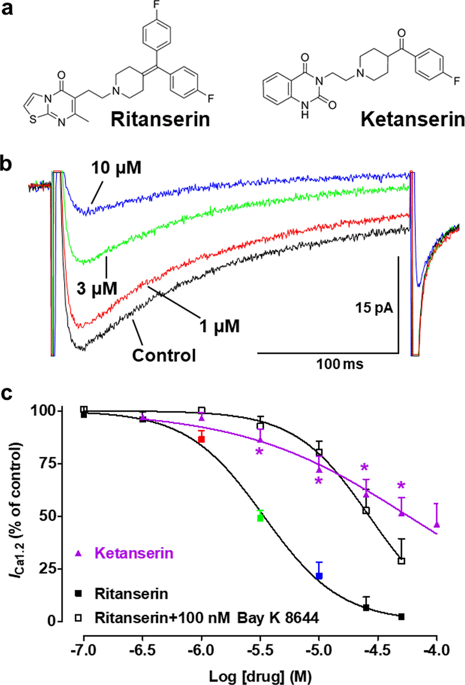Acta Pharmacologica Sinica ( IF 6.9 ) Pub Date : 2020-03-04 , DOI: 10.1038/s41401-020-0370-1 Fabio Fusi 1 , Alfonso Trezza 1 , Giampietro Sgaragli 2 , Ottavia Spiga 1 , Simona Saponara 2 , Sergio Bova 3

|
CaV1.2 channel blockers or 5-HT2 receptor antagonists constitute effective therapy for Raynaud’s syndrome. A functional link between the inhibition of 5-HT2 receptors and CaV1.2 channel blockade in arterial smooth muscles has been hypothesized. Therefore, the effects of ritanserin, a nonselective 5-HT2 receptor antagonist, on vascular CaV1.2 channels were investigated through electrophysiological, functional, and computational studies. Ritanserin blocked CaV1.2 channel currents (ICa1.2) in a concentration-dependent manner (Kr = 3.61 µM); ICa1.2 inhibition was antagonized by Bay K 8644 and partially reverted upon washout. Conversely, the ritanserin analog ketanserin (100 µM) inhibited ICa1.2 by ~50%. Ritanserin concentration-dependently shifted the voltage dependence of the steady-state inactivation curve to more negative potentials (Ki = 1.58 µM) without affecting the slope of inactivation and the activation curve, and decreased ICa1.2 progressively during repetitive (1 Hz) step depolarizations (use-dependent block). The addition of ritanserin caused the contraction of single myocytes not yet dialyzed with the conventional method. Furthermore, in depolarized rings, ritanserin, and to a lesser extent, ketanserin, caused a concentration-dependent relaxation, which was antagonized by Bay K 8644. Ritanserin and ketanserin were docked at a region of the CaV1.2 α1C subunit nearby that of Bay K 8644; however, only ritanserin and Bay K 8644 formed a hydrogen bond with key residue Tyr-1489. In conclusion, ritanserin caused in vitro vasodilation, accomplished through the blockade of CaV1.2 channels, which was achieved preferentially in the inactivated and/or resting state of the channel. This novel activity encourages the development of ritanserin derivatives for their potential use in the treatment of Raynaud’s syndrome.
中文翻译:

藤黄精蛋白阻断大鼠动脉平滑肌中的CaV1.2通道:电生理,功能和计算研究。
Ca V 1.2通道阻滞剂或5-HT 2受体拮抗剂构成雷诺氏综合症的有效疗法。在动脉平滑肌中5-HT 2受体的抑制与Ca V 1.2通道阻滞之间存在功能联系。因此,通过电生理,功能和计算研究研究了非选择性5-HT 2受体拮抗剂利坦色林对血管Ca V 1.2通道的作用。利他丝精以浓度依赖的方式(K r = 3.61 µM)阻断Ca V 1.2通道电流(I Ca1.2)。我Ca1.2抑制作用被Bay K 8644拮抗,洗脱后部分恢复。相反,利坦色林类似物酮色林(100 µM)抑制I Ca1.2约50%。利他丝林浓度依赖性地将稳态灭活曲线的电压依赖性移至更多的负电势(K i = 1.58 µM),而不会影响灭活的斜率和激活曲线,并且降低了I Ca1.2在重复(1 Hz)逐步去极化(取决于使用情况的块)期间逐步进行。利坦色林的加入导致尚未用常规方法透析的单个心肌细胞收缩。另外,在去极化环,利坦色林,以及在较小程度上,酮色林,引起了浓度依赖性舒张,这是由湾ķ8644.利坦色林和酮色林拮抗在CA的区域对接到V 1.2α 1C亚基附近的那海湾K 8644; 然而,只有利坦色林和Bay K 8644与关键残基Tyr-1489形成氢键。总之,利坦色林引起体外血管舒张,通过阻断Ca V来实现1.2个通道,优先在通道的非激活和/或静止状态下实现。这项新颖的活动促进了ritanserin衍生物的发展,因为它们可能用于治疗雷诺氏综合症。











































 京公网安备 11010802027423号
京公网安备 11010802027423号